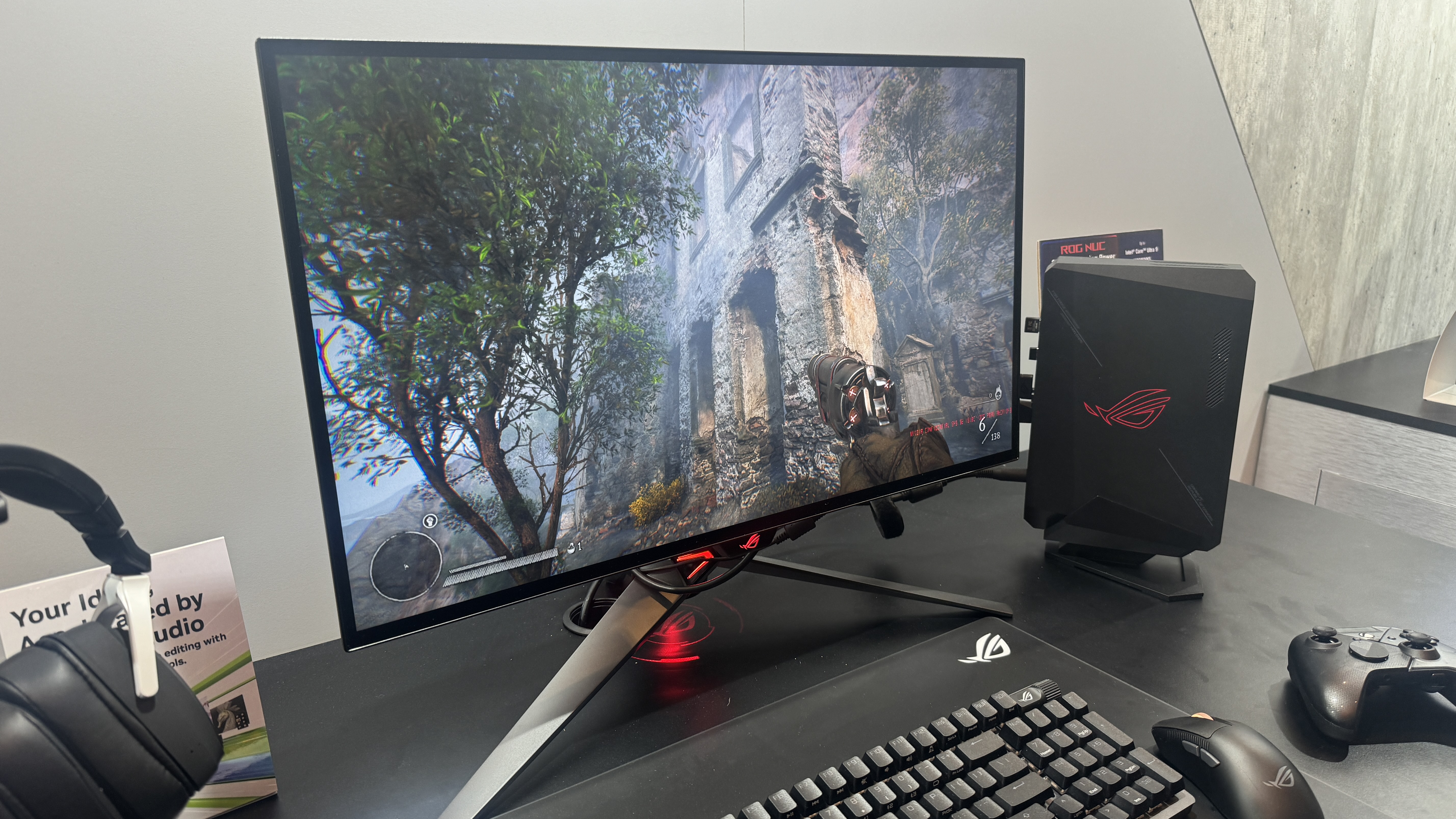Asus' first gaming NUC uses Intel Core Ultra, up to RTX 4070 in a 2.5-liter chassis
Mobile parts power this new tiny gaming PC.

In July, Intel left the NUC business and gave Asus a license to produce its own designs. At CES 2024 in Las Vegas, Asus is showing off its first gaming-focused design, the Asus ROG NUC.
There will be two configurations: one with an Intel Core Ultra 7 155H and an Nvidia GeForce RTX 4060 Laptop GPU, and another with a Core Ultra 9 185H and RTX 4070 Laptop GPU. Those are all mobile parts to fit into a 2.5-liter chassis.
We don't have exact RAM and storage numbers, though the spec sheet says the system has two DDR5 SO-DIMM slots (maxing out at 32GB per slot, or 64GB total) and offers three M.2 2280 PCIe Gen 4 SSD slots. It sounds like there will be room for upgrades.



The front of the system has an SD card reader (UHS-1), a pair of USB 3.2 Gen 2 Type-A ports, and a 3.5 mm audio jack, while the back boasts a Thunderbolt 4 (USB Type-C) port, two more USB 3.2 Gen 2 Type-A ports, a pair of USB 2.0 ports, an Ethernet jack, an HDMI 2.1 port and two DisplayPort 1.4 ports. Additionally, the laptop supports Wi-Fi 6E with a Killer WiFi 6E AX1690i card.
We saw the system in its included vertical stand, which is great because it takes up less desk space. But if you prefer it sideways, you can always place it on the prominent rubberized feet on one side of the PC.


The design to get inside is largely tool-free, though there is a single screw, which Asus told us is to keep an internal battery (likely CMOS) out of children's hands and digestive tracks. Still, Asus says it takes less than ten minutes to get into the system and make changes.
Asus apparently codenamed the device "Scorpion Canyon." When Intel made NUCs, these names were common among enthusiasts to refer to different generations, especially among the skull-clad NUC Enthusiast line. Seeing Asus keep the tradition going is fun, but we'll see if it sticks.
Representatives for Asus on the show floor would only tell us that the NUC is coming "soon." We don't have firm prices, but they suggested the Ultra 7 with an RTX 4060 could be around $1,700 to $1,800, while the configuration with an Ultra 9 and RTX 4070 could go as high as $2,100 - $2,200, but take those early prices with a grain of salt.
Get Tom's Hardware's best news and in-depth reviews, straight to your inbox.

Andrew E. Freedman is a senior editor at Tom's Hardware focusing on laptops, desktops and gaming. He also keeps up with the latest news. A lover of all things gaming and tech, his previous work has shown up in Tom's Guide, Laptop Mag, Kotaku, PCMag and Complex, among others. Follow him on Threads @FreedmanAE and BlueSky @andrewfreedman.net. You can send him tips on Signal: andrewfreedman.01
- Sarah Jacobsson PurewalSenior Editor, Peripherals
-
ThomasKinsley You can get a 13th gen Intel laptop with a 4070 and a 240hz 1600p screen for $1,999. The NUC is missing the screen and battery, so I'm not quite sure the value proposition is there.Reply -
thestryker The NUC line has never been a value proposition when it comes to the higher end ones. They've almost always ended up being at least $200-300 more than you could build or get something relatively equivalent. The form factor taxes have been very real, and it sounds like Asus isn't changing that (though maybe the pricing will be lower than the guesstimate).Reply -
Neilbob At least it can hold more than the recommended daily water intake.Reply
(Since when were PC cases sized using a fluid volume measurement? Is that a thing I somehow missed?) -
Notton Reply
It most likely has better thermals and power envelope. For instance, instead of 100W shared TDP, it could allow max TDP on both CPU and GPU.ThomasKinsley said:You can get a 13th gen Intel laptop with a 4070 and a 240hz 1600p screen for $1,999. The NUC is missing the screen and battery, so I'm not quite sure the value proposition is there.
3x 2280 NVMe slots is something you can only find on >17 laptops, and even those tend to max out at something like 250W TDP.
With that said, 4060/4070 mobile would not be my first choice, as that means there's no PCIe slot.
It's been a thing for at least 15 years.Neilbob said:At least it can hold more than the recommended daily water intake.
(Since when were PC cases sized using a fluid volume measurement? Is that a thing I somehow missed?)
If I had to guess, probably around 2001, back when mITX was first introduced, and Shuttle shoe box style PCs were a thing.
It's more of a thing with mITX and mATX. No one cares how much volume a full ATX case occupies, and the concern is more towards "will this fit?" -
Neilbob Reply
Wow. Well, it somehow passed me by completely. Or I just wasn't paying enough attention. That's far more likely :)Notton said:It's been a thing for at least 15 years. -
salgado18 I can't swallow no-upgradeability on notebooks anymore, and this has the same problem. After a few years it will be obsolete, and you'll either have to purchase a brand new one (recycling the old), or build/buy a larger system, because there are no gaming NUCs available at the time (unlikely, but possible). Give me a new tiny form factor specification, and make parts of that spec, so I can build my own, and upgrade on the way.Reply